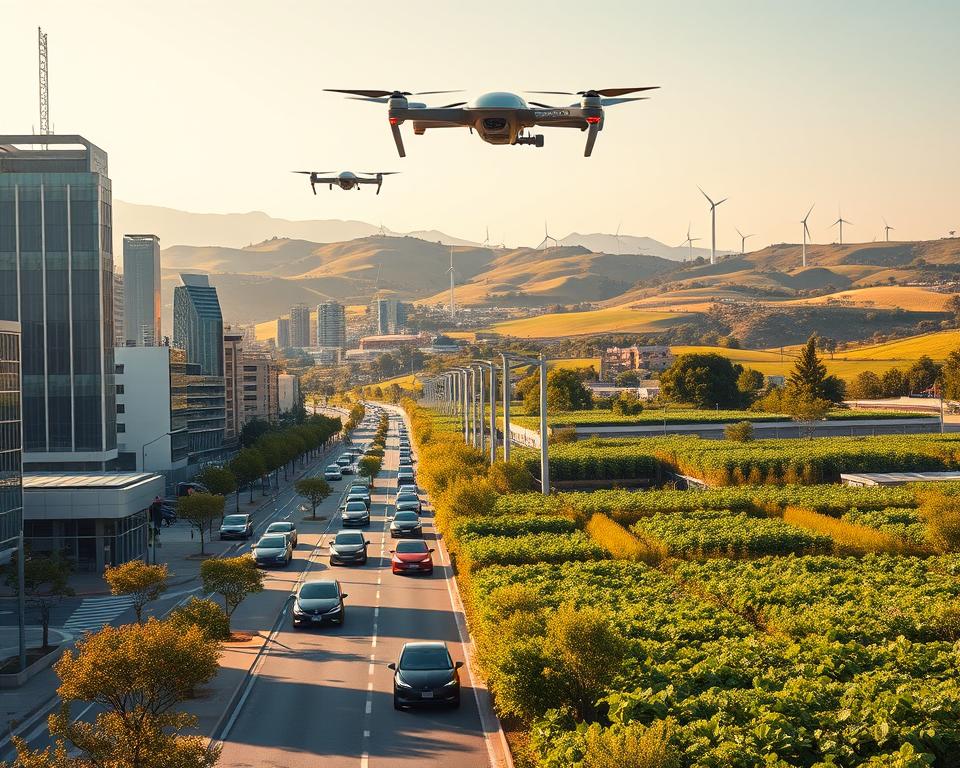Anunțuri
Can one household choice really shift the odds on climate? That question frames this short guide for 2025.
You’ll get up-to-date context, practical guidance, and real examples you can use at home and at work. Big players matter: 57 companies are tied to roughly 80 percent of CO2 emissions. Still, every organization and household plays a role.
Google reports 99 percent plastic-free packaging now and aims for 100 percent by 2025. Typical U.S. cars emit about 4.6 metric tons of CO2 per year. Small moves add up: one-minute shorter showers could save 170 billion gallons annually.
Read on for clear ways and practical practices that connect policy, markets, and investor trends to actions you can try. Expect simple language, short steps, and measured ideas you can track.
Sfat: This guide shows quick wins and bigger shifts, and helps you spot greenwashing so your choices make real impact without overpromising results.
Anunțuri
Introduction: Why Sustainability examples in 2025 are more relevant than ever
Sustainability examples in 2025 help you turn big climate change goals into daily actions. Policy shifts, investor focus, and consumer preferences now reward clear, verifiable steps. Over 80 percent of CO2 links to 57 companies, which is why ESG scrutiny has grown and data-backed reporting matters.
What’s changed: Policy, consumer behavior, and investor focus
Regulations are tighter and investors ask for measurable targets. Consumers favor brands with credible claims. Businesses use LEED, FSC, and transparent disclosures to show progress.
How this list helps you act at home and in business
This list saves you timp by highlighting low-lift moves and strategic shifts with clear outcomes. Start with simple swaps to reduce carbon footprint, then add operational changes that cut emissions over time.
Anunțuri
- Energy, water, packaging, transportation, and reporting are covered.
- Brand cases—like Apple’s supplier clean energy work and Google’s near plastic-free packaging—illustrate what works.
- Treat these as guidance: tailor efforts to your context and revisit plans as markets change.
Sustainability examples for everyday life at home
Start with easy swaps that lower trash, save money, and reduce upstream impacts from products. Replacing disposables with reusables cuts waste and the hidden emissions tied to single-use packaging.
Reduce your carbon footprint with smarter consumption:
- Swap paper towels and plastic wrap for cloth napkins and silicone covers. Bring your own mug and bottle.
- Plan meals, check your pantry before shopping, and freeze leftovers to cut food waste.
- Compost food scraps where possible — organic waste in landfills makes methane, a potent greenhouse gas.
Real actions: Reusables, low-waste swaps, and proper recycling
Learn local recycling rules, keep items clean and dry, and don’t “wishcycle.” Contamination can push whole loads to landfills instead of being processed.
Practical steps you can take now:
- Use the right bins for glass, paper, and plastics to avoid contamination.
- Buy in bulk with your own containers and choose products with minimal or compostable packaging.
- Choose durable goods and repair rather than replace to cut future waste to landfills.
Food, diet, and waste: Simple ways to cut greenhouse gas emissions
Small shifts in what you buy and how you store food can cut greenhouse gas emissions and save money. Plan meals, use proper storage, and repurpose scraps to keep organics out of landfills. Composting diverts material that would otherwise release methane as it breaks down.
Plan, store, and compost to keep food out of landfills
Make a short shopping list and store perishable items where they stay visible so nothing gets forgotten. Freeze extra portions and use clear labels with dates.
Compost when you can: even a small bin or local drop-off cuts landfill waste and reduces greenhouse gas emissions from decomposing organics.
Plant-forward meals that lower emissions without rigid rules
Try flexible steps like Meatless Mondays or smaller meat portions. A study shows that if Americans ate plant-based half the time, diet-related emissions could fall about 35 percent.
- Use leftovers creatively and freeze extras to save money and the water embedded in food production.
- Choose seasonal produce and local materials when practical to lower transport impacts and extend shelf life.
- Drink tap water instead of bottled to cut single-use plastic and conserve upstream resources.
For more on food and climate, see the food and climate science resources.
Energy and buildings: Practical steps for efficiency and clean power
Begin with no-regret actions that cut waste and lower costs, then scale to bigger projects.
Quick wins:
Quick wins: LEDs, smart controls, and unplugging devices
Replace incandescent and CFL bulbs with LEDs to cut lighting energy. Add motion sensors in low-use rooms to avoid wasted light.
Use smart thermostats and advanced power strips so idle devices stop drawing power. Unplug chargers and equipment when not needed.
Bigger moves: Renewable energy plans, efficient HVAC, and LEED spaces
Maintain HVAC systems, seal air leaks, and choose reflective roofing to lower cooling demand. Efficient HVAC and insulated envelopes reduce carbon and improve comfort.
Check if your utility offers green power or community solar before investing in rooftop solar. When you lease or buy, ask about LEED or ENERGY STAR ratings as long-term practices that protect value and reduce emissions.
- Start with an energy audit to target top-return projects.
- Prioritize ENERGY STAR appliances and electric water heaters.
- Schedule upgrades over time so costs and disruption stay manageable.
Sfat: Treat these steps as a roadmap: quick fixes first, then capital projects guided by audits and local resources.
Packaging and circularity: Cutting waste across products and supply chains
Smart packaging design cuts waste and makes reuse, repair, and recovery easier. Think of packaging as part of a product’s life, not just a wrapper.
Circular design means choosing fewer parts, mono-materials, and clear end-of-life paths. That lowers contamination in recycling streams and raises recovery rates.
Design for less: minimal, recycled, and reusable packaging
Reduce volume with right-sized boxes and remove loose fillers. Pick materials with high recycled content and known recycling routes.
Where you can, build reuse systems: refill packs, deposit-return containers, or durable shippers that get used many times.
Real-world cases and measurable moves
Google reached 99% plastic-free packaging and aims for 100% by 2025. About 34% of device plastics are recycled today, with a 50% target next.
- Use mono-materials to simplify sorting and reduce waste.
- Add QR codes with disposal instructions and double-seal mailers to ease returns.
- Track metrics: weight reduction, recycled content, and recovery rates as part of your sustainability initiatives.
Water stewardship: Everyday conservation and digital-era realities
How you use water at home and online shapes local supplies and broader climate outcomes. Small fixes cut bills and reduce the energy tied to heating and cooling.
The EPA notes that shaving one minute off showers could save the U.S. about 170 billion gallons of water annually. Data centers also have a measurable water footprint for cooling, so your choice of web hosts matters for resource use.
Practical steps you can take now:
- Install low-flow fixtures, fix leaks fast, and shorten showers to save water and the energy used to heat it.
- Choose native landscaping and efficient irrigation to lower outdoor use and boost resilience in a warming climate.
- For business, assess facility and supplier use, set reduction targets, and track progress as part of your sustainability goals.
- Pick web hosts and data partners that report transparent water and energy practices.
- Support forest ecosystem services by sponsoring watershed protection and then share the impact with staff and customers.
Sfat: Communicate measurable wins so your team and customers see real, steady impact from water actions.
Sustainable transportation choices that lower your carbon footprint
Small changes to how you commute can meaningfully cut emissions and simplify your routine.
The typical passenger vehicle emits about 4.6 metric tons of CO2 per year. You can lower that number by reducing trips, combining errands, or choosing cleaner modes.
Walk or bike for short trips, take public transit, or work remote when possible. These simple shifts reduce gas emissions and the energy used per trip.
If you must drive, keep tires properly inflated, plan routes, and consider an EV or hybrid when replacing your vehicle.
For businesses, favor sea freight over air freight and pick lower-emissions carriers. Right-size packaging and products so shipments are lighter and fewer.
- Choose closer, cleaner ways: walk, bike, or use transit to reduce gas emissions and energy use.
- Cut trips: consolidate errands, carpool, or enable hybrid work to reduce total miles driven.
- Optimize logistics: slower shipping, better routing, and lighter products lower the transportation carbon footprint.
Sustainability examples for business strategy and marketing
Good strategy begins with clear metrics that you can track and prove. Start by setting baselines, owners, and timelines so every initiative ties to measurable results.
Data-driven initiatives turn broad aims into regular reports. Use third-party frameworks and verified dashboards to measure scope 1–3 emissions, water, and waste. Tools like EcoCart can help by offering carbon dashboards and offset tracking you can cite in reports.
Low-lift to high-impact actions include digitizing forms to cut paper, choosing green web hosting, and switching to eco-friendly shipping materials. These quick wins lower cost and show progress while you plan bigger capital projects.
Credible storytelling and guardrails
Publish your methodology, third-party reviews, and the limits of your data to avoid greenwashing. Be transparent about what you measure and what you cannot yet claim.
Practical steps you can follow
- Set science-aligned sustainability goals with baselines, milestones, and clear owners; audit and report regularly.
- Launch low-lift wins first: digitize ops, pick green hosting, and upgrade shipping materials for quick impact.
- Train teams on sustainability practices and messaging so your public story matches operations.
- Offer dashboards, FAQs, and certifications so customers and investors can verify progress.
Real-world example: Apple’s supplier clean energy programs show how one firm can extend influence across its value chain and drive measurable energy reductions.
Supply chain, ESG, and community: Building resilient, ethical operations
Start by mapping your supply chain to spot risks, rights gaps, and high-impact suppliers. That map becomes the foundation for supplier rules, audits, and local partnerships that support long-term performance.
Supplier standards and audits
Create clear codes of conduct that require audits, escalation paths, and remediation. Make corrective plans standard so problems get fixed fast.
Certifications and nature-based services
Choose certified materials like FSC-certified wood and aim for LEED-rated facilities to raise environmental performance. Sponsor forest ecosystem services to protect biodiversity and secure water purification near supply hubs.
Social impact and community partnerships
Engage local stakeholders, protect Indigenous rights, and support fair wages and safe work. One strong example is IFO in the Republic of Congo, which pays above the national minimum and subsidizes healthcare, improving livelihoods while managing resources responsibly.
- Create supplier standards with audits and remediation to embed sustainable business practices.
- Map critical resources and risks across tiers to build resilience and align sourcing with your ESG goals.
- Report social outcomes alongside environmental metrics so customers see a complete picture of performance.
Measurement, KPIs, and transparency: From baselines to progress
Begin by naming the few metrics that matter most and build simple routines to collect them. Pick indicators that map directly to your sustainability goals so you focus effort where it counts.

What to track
Track energy consumption, greenhouse gas emissions, recycling rates, and water use across sites and suppliers.
Make each KPI measurable: set units, owners, and baselines so you can compare month to month.
Tools and cadence
Use scorecards and dashboards for visibility. Aim for a quarterly check and an annual public report.
- Scorecards: unit-level data that managers review monthly.
- Dashboards: rolling trends for executives and customers.
- Third-party review: get assurance to validate methods and avoid green claims that can’t be proven.
Improve recycling rates with clearer signage, vendor take-back programs, and supplier recycled-content requirements.
Monitor water closely, especially if you rely on data centers; choose hosts that report ethical cooling and reduced water stress.
Document the steps you’ll take when targets slip: corrective actions, revised timelines, and transparent updates for stakeholders. Tools like EcoCart can help with carbon dashboards and customer-facing reporting as you scale your measurement program.
Concluzie
End with practical moves you can try now that add up over months and years. Pick one or two initiatives this year — like switching to renewable energy or cutting single-use packaging — and set a simple target.
Track progress with a short list of KPIs so you can see how small steps reduce carbon and waste. Households can cut transport emissions (about 4.6 metric tons CO2 per car per year) and save water (shorter showers scale to 170 billion gallons nationally).
Utilizare verified partners and consult qualified professionals for audits, installations, or supply chain changes. Learn from companies such as Apple and Google that report year-over-year gains from clear sustainability initiatives.
Keep your footprint visible, stay transparent about what works, and let steady efforts guide bigger change and lasting impact.



